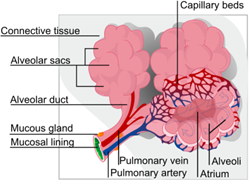What Is an Alveolus?

An alveolus (plural: alveoli, from Latin alveolus, "little cavity") is an anatomical structure that has the form of a hollow cavity. Found in the lung, the pulmonary alveoli are spherical outcroppings of the respiratory sites of gas exchange with the blood. Alveoli are particular to mammalian lungs. Different structures are involved in gas exchange in other vertebrates. The alveolar membrane is the gas-exchange surface. The blood brings carbon dioxide from the rest of the body for release into the alveoli, and the oxygen in the alveoli is taken up by the blood in the alveolar blood vessels, to be transported to all the cells in the body.
Each human lung contains about 300 million alveoli. Each alveolus is wrapped in a fine mesh of capillaries covering about 70% of its area. An adult alveolus has an average diameter of 200 to 300 microns, with an increase in diameter during inhalation.
|